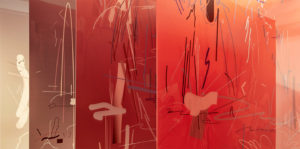
Animation explores its existence in space. As a multifaceted interdisciplinary profession in the moving image production, it finds new fields that transfer the two-dimensional space of the screen to spatial configurations and settles in multidimensional environments. This is most evident in the art field and in augmented and virtual space, because the question of the spatiality of animation arises differently in these two fields than in the plane of the screen. The space within the medium is joined by extramedial phenomena which affect both the (bodily) receptivity to animated images as well as the structures of mediation. The changes in the dispositive are so fundamental that various epithets have been proposed for the new phenomena: extended, expanded, immersive, relocated, exhibited, site-specific, spatial. They accompany the appearance of moving images in art or in virtual space – and culminate in the proposal of a topological media science that is to provide a vocabulary for the discussion of the new, spatial configurations of time-based and interactive formats.
The 6th Conference 2022 of the AG Animation in Lucerne addresses the forms and formats of animated film in spatial dimensions: How do animated images operate in different dispositives? How is space staged in different animation techniques and where can interesting new ways of dealing with it be found? Even when working in two dimensions, the inner-medial space of animation can always be fundamentally recreated. Does animation have a specific awareness of the structural principles and practical modes of functioning of cinematic space? Are there divergent conceptions of ‚real‘ or ‚virtual‘ space or new forms to be found in animation?
Fields of investigation in which the current dimensions of animation are developed include the immersive environments of virtual reality and games, the art and exhibition spaces in which animation is increasingly received, the hybrid, changeable and walkable spaces of artistic performances, of theatre, and in mappings or various uses of media facades in urban space. However, the discussion on the dimensions of animation shall also be discussed within classical animated film: for example, with questions about the omission of space, about worldbuilding or layering in artistic animated film, about the spatiality of stop-motion film, but also of sound in the spaces of animation. In applied form, animation is involved in the measurement of the world and the visualisation of space. Its interventions can be taken as an occasion to reflect on everyday and political spaces, as they can be found in video conferences or at borders, in corridors and waiting rooms of global migration, tourist and commodity flows. And finally, space should also be put up for discussion in terms of media theory and media aesthetics or in terms of production technology, because new categories of spatiality(ies) in animated film make necessary new concepts of their theorisation.
Conference website http://ag-animation.de/
Submission Link https://easychair.org/cfp/CAGA2022
NEW SUBMISSION DEADLINE: June 30th 2022
Submission Guidelines
In response to the theme Dimensions of Animation, we call for academics and artists to propose 20-minute presentations in English or German. The proposal should include an abstract of no more than 300 words (including references) and a short biography of no more than 100 words.
We provide institutions, organizations, and festivals that specialize in researching, collecting, and performing animation the opportunity to present their work in a separate panel and offer to exchange ideas about cooperation. We, therefore, invite them to also register by 30.06.2022 with a brief outline of their field of activity. The format will be arranged with all the participants before the conference.
All selected speakers will be invited to present at the Lucerne University of Applied Sciences and Arts. No costs for travel or accommodation can be covered. However, we will be happy to assist you in finding affordable accommodation in Luzern.
List of Topics
- Animation as a form of knowledge and an object of media theory
- Dimensions of animation research as a scientific discipline/interdiscipline
- The animated space as a dimension in media theory
- Animated knowledge spaces
- Software apps for space capture/tracking
- Elements of animation
- Animated bodies and corporeality
- Representation of nature in animation
- Sound and space in animation
- Spatiality in 2D animation and in stop-motion animation
- Hybrid spaces. Set extensions/VFX, etc.
- Generative art and animation
- Artificial intelligence
- Multidimensionality (multi-perspective) in animation
- Expanded animation
- Animation as a form of expression in art
- Animation as a form of art or communication in public space
- Animation, performance, play, and theatre
- Augmented reality
- Animation and games
- Interactive environments in virtual spaces
- Animation in metaverses
Committees
Program & Organizing Committee
- Franziska Bruckner, University of Applied Sciences St. Pölten
- Juergen Haas, Lucerne University of Applied Sciences and Arts
- Juergen Hagler, University of Applied Sciences Upper Austria
- Kathi Käppel, Lucerne University of Applied Sciences and Arts
- Fred Truniger, Lucerne University of Applied Sciences and Arts
Keynote Speakers
- Ed Atkins
- Erika Balsom
- Chris Pallant
- Peggy Schoenegge
Venue
The conference will be held at the Lucerne University of Applied Sciences and Arts.
Contact
All questions about submissions should be emailed to ta.grebnegah-hfnull@relgah.negreuj.
